Dynamic Modelling and Techno-Economic Assessment of a Compressed Heat Energy Storage System: Application in a 26-MW Wind Farm in Spain
Abstract
1. Introduction
- Development of a transient thermal model of a CHEST system, using the TRNSYS simulation program [20], which includes the thermodynamic interactions of the HTHP and ORC, their partial load behavior, and the power profile of the available energy to charge the system.
- Techno-economic assessment of the CHEST system when introduced to the Spanish technical constraints market, using real data of a 26-MW wind power plant for the year 2018. Different capacities and charging conditions for the CHEST system were studied in order to find a suitable solution for the power plant under study.
2. CHEST Concept
3. Dynamic Modelling of the CHEST System
3.1. General Structure of the TRNSYS-CHEST Model
- Size of the equipment: nominal input power to the HTHP in MW (P_el_in_nom_HP) and net output power from the ORC in MW (P_el_net_nom_ORC).
- Dimensions of the TES systems: volume of SHS’s water tanks in m3 (V_w_max_SHS) and energy capacity of the LHS system in MWh (E_q_max_LHS).
- Inlet water temperatures and temperature differences of the source (Twi_evap, and dT_w_evap) and sink (Twi_cond, and dT_w_cond).
3.2. Modelling of the HTHP and ORC
3.3. Control Strategies
3.4. Performance of the System
3.5. Economic Assessment
4. Spanish Energy Market and CHEST System Integration
5. Results and Discussion
- Economic grants for the implementation of large-scale energy storage technologies to guarantee the stability of the electrical grid.
- A bigger differentiation between the minimum and maximum energy prices along the day. In this situation, more profit could be obtained from the operation of the system in purchase-sale operational mode, hereby reducing the payback of the system.
- Economies of scale and improvements in the technologies that compose the CHEST system may reduce the unitary fabrication cost of the equipment, facilitating its implementation.
- A future increase in the share of renewable energy production leading to moments of energy surplus on the electrical grid that can boost the necessity of energy storage techniques and increase the annual benefits.
6. Conclusions and Future Work
- The Spanish electricity grid was analyzed to find a possible integration scenario of the CHEST system. A novel application was proposed in the technical constraints market, where electrical energy is available for the charging process, taking advantage of the energy reduction with respect to the based daily operating scheduled. The discharged energy is then sold in the market at peak hours.
- High values of roundtrip efficiency were achieved (above 90%) for all the studied cases using the working temperatures specified for working mode 2 (Twi_evap = 80 °C and Twi_cond = 10 °C).
- The results show that by purchasing energy, the contribution of the CHEST system to the power plant increases, but its efficiency is reduced, and the cost of each MWh produced increases. Small capacities have demonstrated a better response to market fluctuations. Case 3.A, with 5 MW of installed power and providing 5% of the energy produced, appears to be a good solution for the power plant under study.
- If the CHEST system is built with a capital cost in the range 200–650 k€ per installed MW, the system could be potentially feasible. This value is in the range of previous literature, although this issue should be treated with caution, since to date, there is still no experimental installation of such a system.
Author Contributions
Funding
Acknowledgments
Conflicts of Interest
Abbreviations
| CAES | Compressed air energy storage |
| CAPEX | Capital expenditure |
| CHEST | Compressed heat energy storage |
| COP | Coefficient of Performance |
| GWP | Global warming potential |
| HTHP | High temperature heat pump |
| HTWT | High temperature water tank |
| LHS | Latent heat storage |
| LTWT | Low temperature water tank |
| ORC | Organic Rankine cycle |
| PB | Payback |
| PCM | Phase change material |
| PHS | Pumped hydro storage |
| PLR | Partial load ratio |
| PTES | Pumped thermal energy storage |
| RESs | Renewable energy sources |
| SHS | Sensible heat storage |
| SO | System operator |
| TES | Thermal energy storage |
Nomenclature
| Variable | Unit | Description |
| COP100 | - | Nominal COP of the HTHP when working at full load. |
| Cpw | kJ/kg.K | Specific heat of water. |
| dT_w_evap | K | Water temperature difference in HTHP’s evaporator. |
| dT_w_cond | K | Water temperature difference in ORC’s condenser. |
| E_q_LHS | MWh | Amount of energy stored in the LHS unit. |
| E_q_max_LHS | MWh | Maximum heat that can be stored in the LHS unit. |
| En_price_hour | €/MWh | Hourly energy price in the SPOT market for the year 2018 in Spain. |
| En_price_month | €/MWh | Average price of the energy per month in the SPOT market for the year 2018 in Spain. |
| m_w_preh | kg/h | Water mass flow rate in ORC’s preheater. |
| m_w_subc | kg/h | Water mass flow rate in HTHP’s subcooler. |
| m_w_est_preh | kg/h | Estimated water mass flow rate in ORC’s preheater. |
| m_w_est_subc | kg/h | Estimated water mass flow rate in HTHP’s subcooler. |
| Net_profit | K€ | Net profit of the CHEST system for the year 2018. |
| P_el_in_HP | MW | Net electrical power employed in HTHP’s compressor. |
| P_el_in_est_HP | MW | Estimated electrical power used in HTHP’s compressor. Without considering TES sizing restrictions. |
| P_el_in_nom_HP | MW | Nominal electrical power of the HTHP’s compressor when HTHP works at full load. |
| P_el_net_ORC | MW | Net electrical power produced by the ORC’s expander. |
| P_el_net_est_ORC | MW | Estimated net electrical power produced by the ORC’s expander. Without considering TES sizing restrictions. |
| P_el_net_nom_ORC | MW | Nominal net electrical power produced by the ORC’s expander when ORC works at full load. |
| P_q_lat | MW | Actual latent heat stored (positive) or withdrawn (negative) from the LHS unit. Considering TES restrictions. |
| P_q_lat_est_HP | MW | Estimated latent heat stored in the LHS unit. Without considering TES sizing restrictions. |
| P_q_lat_est_ORC | MW | Estimated latent heat withdrawn from the LHS unit. Without considering TES sizing restrictions. |
| P_q_lat_nom_HP | MW | Nominal latent heat of the HTHP’s condenser, when HTHP works at full load. |
| P_q_lat_nom_ORC | MW | Nominal latent heat of the ORC’s evaporator, when ORC works at full load. |
| P_q_sen_HP | MW | Actual sensible heat stored in SHS unit. Considering TES restrictions. |
| P_q_sen_ORC | MW | Actual sensible heat withdrawn from SHS unit. Considering TES restrictions. |
| P_q_sen_est_HP | MW | Estimated sensible heat stored in the SHS unit. Without considering TES sizing restrictions. |
| P_q_sen_est_ORC | MW | Estimated sensible heat withdrawn from the SHS unit. Without considering TES sizing restrictions. |
| P_q_sen_nom_HP | MW | Nominal sensible heat of the HTHP’s subcooler, when HTHP works at full load. |
| P_q_sen_nom_ORC | MW | Nominal sensible heat of the ORC’s preheater, when HTHP works at full load. |
| Purchased_power | MW | Power purchased in the SPOT market to charge the CHEST system. |
| T_HTWT | °C | Temperature of the water contained in the HTWT. |
| T_LTWT | °C | Temperature of the water contained in the LTWT. |
| T_w_out_preh | °C | Water temperature at preheater’s outlet. |
| T_w_out_subc | °C | Water temperature at subcooler’s outlet. |
| Tech_Const_pwr | MW | Power available from technical constraints to charge the CHEST system. |
| Twi_cond | °C | Inlet water temperature of ORC’s condenser. |
| Twi_evap | °C | Inlet water temperature of HTHP’s evaporator. |
| V_w_HTWT | m3 | Volume of water contained in the HTWT. |
| V_w_LTWT | m3 | Volume of water contained in the LTWT. |
| V_w_max_SHS | m3 | Maximum volume of water that can be stored in the SHS tanks. |
References
- Amanpour, S.; Huck, D.; Kuprat, M.; Schwarz, H. Integrated energy in Germany—A critical look at the development and state of integrated energies in Germany. Front. Energy 2018, 12, 493–500. [Google Scholar] [CrossRef]
- Nikolaou, T.; Stavrakakis, G.S.; Tsamoudalis, K. Modeling and optimal dimensioning of a pumped hydro energy storage system for the exploitation of the rejected wind energy in the non-interconnected electrical power system of the Crete Island, Greece. Energies 2020, 13, 2705. [Google Scholar] [CrossRef]
- Shi, J.; Yang, Y.; Deng, Z. A reliability growth model for 300 MW pumped-storage power units. Front. Energy Power Eng. China 2009, 3, 337–340. [Google Scholar] [CrossRef]
- Argyrou, M.C.; Christodoulides, P.; Kalogirou, S.A. Energy storage for electricity generation and related processes: Technologies appraisal and grid scale applications. Renew. Sustain. Energy Rev. 2018, 94, 804–821. [Google Scholar] [CrossRef]
- Jockenhöfer, H.; Steinmann, W.D.; Bauer, D. Detailed numerical investigation of a pumped thermal energy storage with low temperature heat integration. Energy 2018, 145, 665–676. [Google Scholar] [CrossRef]
- Steinmann, W.D. Thermo-mechanical concepts for bulk energy storage. Renew. Sustain. Energy. Rev. 2017, 75, 205–219. [Google Scholar] [CrossRef]
- Thess, A. Thermodynamic efficiency of pumped heat electricity storage. Phys. Rev. Lett. 2013, 111, 1106102. [Google Scholar] [CrossRef]
- Guo, J.; Cai, L.; Chen, J.; Zhou, Y. Performance optimization and comparison of pumped thermal and pumped cryogenic electricity storage systems. Energy 2016, 106, 260–269. [Google Scholar] [CrossRef]
- Attonaty, K.; Stouffs, P.; Pouvreau, J.; Oriol, J.; Deydier, A. Thermodynamic analysis of a 200 MWh electricity storage system based on high temperature thermal energy storage. Energy 2019, 172, 1132–1143. [Google Scholar] [CrossRef]
- Frate, G.F.; Antonelli, M.; Desideri, U. A novel Pumped Thermal Electricity Storage (PTES) system with thermal integration. Appl. Therm. Eng. 2017, 121, 1051–1058. [Google Scholar] [CrossRef]
- Mateu-Royo, C.; Mota-Babiloni, A.; Navarro-Esbrí, J.; Peris, B.; Moles, F.; Amat-Albuixech, M. Multi-objective optimization of a novel reversible High-Temperature Heat Pump-Organic Rankine Cycle (HTHP-ORC) for industrial low-grade waste heat recovery. Energy Convers. Manag. 2019, 197, 111908. [Google Scholar] [CrossRef]
- Benato, A. Performance and cost evaluation of an innovative Pumped Thermal Electricity Storage power system. Energy 2017, 138, 419–436. [Google Scholar] [CrossRef]
- Benato, A.; Stoppato, A. Integrated Thermal Electricity Storage System: Energetic and cost performance. Energy Convers. Manag. 2019, 197, 111833. [Google Scholar] [CrossRef]
- Maximov, S.A.; Harrison, G.P.; Friedrich, D. Long term impact of grid level energy storage on renewable energy penetration and emissions in the chilean electric system. Energies 2019, 12, 1070. [Google Scholar] [CrossRef]
- Steinmann, W.D. The CHEST (Compressed Heat Energy STorage) concept for facility scale thermo mechanical energy storage. Energy 2014, 69, 543–552. [Google Scholar] [CrossRef]
- Hu, B.; Wu, D.; Wang, L.W.; Wang, R.Z. Exergy analysis of R1234ze(Z) as high temperature heat pump working fluid with multi-stage compression. Front. Energy 2017, 11, 493–502. [Google Scholar] [CrossRef]
- He, Y.L.; Wang, R.; Roskilly, A.P.; Li, P. Efficient use of waste heat and solar energy: Technologies of cooling, heating, power generation and heat transfer. Front. Energy 2017, 11, 411–413. [Google Scholar] [CrossRef][Green Version]
- Hassan, A.H.; O’Donoghue, L.; Sánchez-Canales, V.; Corberán, J.M.; Payá, J.; Jockenhöfer, H. Thermodynamic analysis of high-temperature pumped thermal energy storage systems: Refrigerant selection, performance and limitations. Energy Rep. 2020, in press. [Google Scholar] [CrossRef]
- Steinmann, W.D.; Bauer, D.; Jockenhöfer, H.; Johnson, M. Pumped thermal energy storage (PTES) as smart sector-coupling technology for heat and electricity. Energy 2019, 183, 185–190. [Google Scholar] [CrossRef]
- Klein, S.A.; Beckman, W.A.; Mitchell, J.W.; Duffie, J.A.; Duffie, N.A.; Freeman, T.L. TRNSYS 18—A Transient System Simulation Program; Solar Energy Laboratory, University of Wisconsin: Madison, WI, USA, 2018. [Google Scholar]
- Lindeman, L.; Sánchez-Canales, V.; O’Donoghue, L.; Hassan, A.H.; Corberan, J.M.; Payá, J. Thermodynamic analysis of a high temperature heat pump coupled with an organic Rankine cycle for energy storage. In Proceedings of the XI National and II International Engineering Thermodynamics Congress, Albacete, Spain, 12–14 June 2019; pp. 1–12. [Google Scholar]
- Hassan, A.H.; Corberán, J.M.; Payá, J.; Stefanou, M.R.; Trebilcock, F. Performance analysis of a high temperature heat pump for compressed heat energy storage system using R-1233zd (E) as working fluid. In Proceedings of the 2nd Conference on High Temperature Heat Pumps, Copenhagen, Denmark, 9 September 2019. [Google Scholar]
- Corberán, J.M.; Hassan, A.H.; Payá, J. Thermodynamic analysis and selection of refrigerants for high- temperature heat pumps. In Proceedings of the 25th IIR International Congress of Refrigeration, Montréal, QC, Canada, 24–30 August 2019; pp. 4705–4712. [Google Scholar] [CrossRef]
- Sánchez-Canales, V.; Hassan, A.H.; Corberán, J.M.; Payá, J.; O´donoghue, L.; Stefanou, M.R. Excess electricity storage via thermal energy storage. In Proceedings of the Eurotherm Seminar #112 (Advances in Thermal Energy Storage), lleida, Spain, 15–17 May 2019; pp. 1–10. [Google Scholar]
- da Cunha, J.P.; Eames, P. Thermal energy storage for low and medium temperature applications using phase change materials—A review. Appl. Energy 2016, 177, 227–238. [Google Scholar] [CrossRef]
- Cecchinato, L. Part load efficiency of packaged air-cooled water chillers with inverter driven scroll compressors. Energy Convers. Manag. 2010, 51, 1500–1509. [Google Scholar] [CrossRef]
- CETIAT. Part-Load Performance Behavior of On-Off and Variable Capacity Heat Pumps; Groundmed: Madrid, Spain, 2010. [Google Scholar]
- Danfoss. The Turbocor Family of Compressors Model TT300, Danfoss TURBOCOR. Datasheet. Available online: www.turbocor.com,USA (accessed on 20 April 2019).
- Fahlén, P. Capacity control of heat pumps. REHVA 2012, 49, 28–31. [Google Scholar]
- Palkowski, C.; Zottl, A.; Malenkovic, I.; Simo, A. Fixing efficiency values by unfixing compressor speed: Dynamic test method for heat pumps. Energies 2019, 12, 1045. [Google Scholar] [CrossRef]
- Estadísticas del Sistema Eléctrico | Red Eléctrica de España. Available online: https://www.ree.es/es/estadisticas-del-sistema-electrico/3015/3001 (accessed on 24 April 2019).
- NÚMERO 115. Boletín Oficial del Estado; Ministerio de Energía, Turismo y Agenda Digital: Madrid, Spain, 2018; p. 49415.
- OMIP Operador del Mercado Ibérico de Energía—Polo Portugués. Available online: https://www.omip.pt/ (accessed on 7 May 2019).
- NÚMERO 301. Boletín Oficial Del Estado; Ministerio de Industria, Energía y Turismo: Madrid, Spain, 2015; p. 303.
- El Mercado de Restricciones Técnicas. Available online: http://mifacturadeluz.com/mercado-de-restricciones-tecnicas/ (accessed on 25 April 2019).
- Puerto Escandón (España)—Parques eólicos—Acceso en línea—The Wind Power. Available online: https://www.thewindpower.net/windfarm_es_2253_puerto-escandon.php (accessed on 30 April 2019).
- Federico Bava DS D2.1 Case studies: User Requirements and Boundary Conditions Definition. CHESTER. Available online: https://www.chester-project.eu/wp-content/uploads/2018/11/CHESTER_D2.1_Case-Studies_v5.0.pdf (accessed on 15 May 2020).
- Estado actual de la energía termosolar (CSP)—HELIONOTICIAS. Available online: http://helionoticias.es/estado-actual-de-la-energia-termosolar-csp/ (accessed on 20 May 2019).
- Gallo, A.B.; Simões-Moreira, J.R.; Costa, H.K.M.; Santons, M.M.; dos Santons, E.M. Energy storage in the energy transition context: A technology review. Renew. Sustain. Energy Rev. 2016, 65, 800–822. [Google Scholar] [CrossRef]
- Smallbone, A.; Jülch, V.; Wardle, R.; Roskilly, A.P. Levelised Cost of Storage for Pumped Heat Energy Storage in comparison with other energy storage technologies. Energy Convers. Manag. 2017, 152, 221–228. [Google Scholar] [CrossRef]
- Proctor, P. Energy storage: A potential game changer and enabler for meeting our future energy needs? In Proceedings of the All Energy Conference, Aberdeen, UK, 22 May 2014. [Google Scholar]
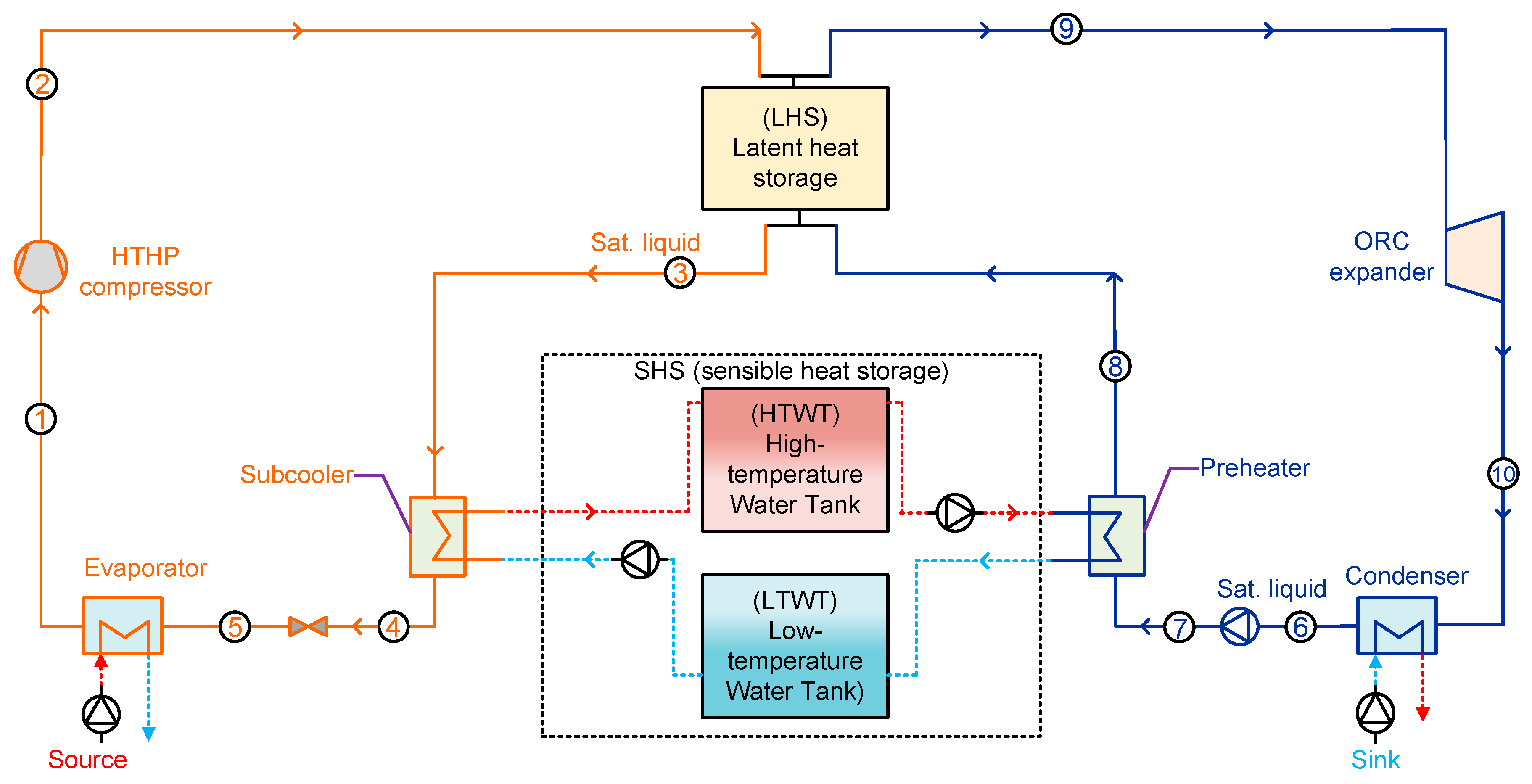
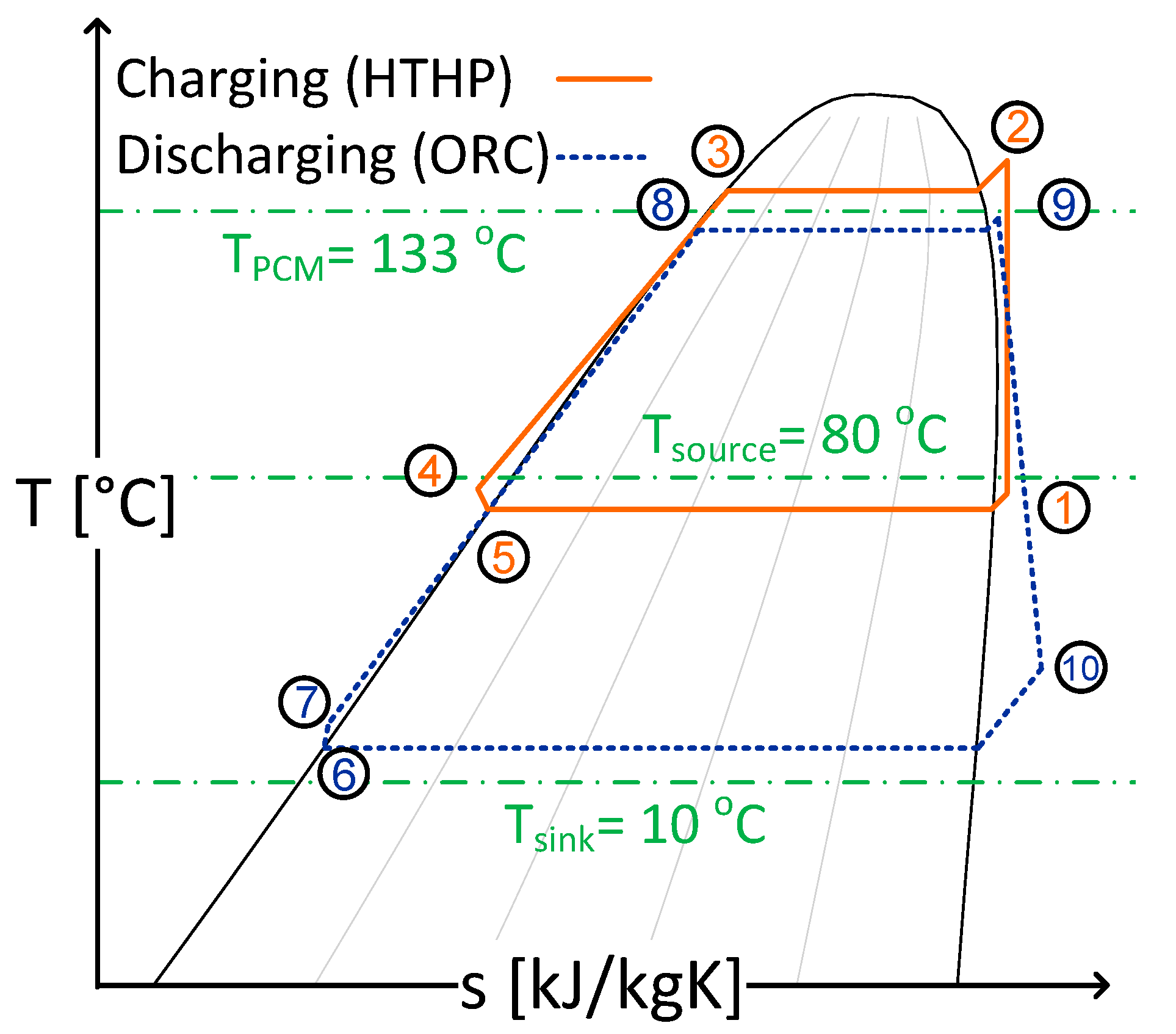

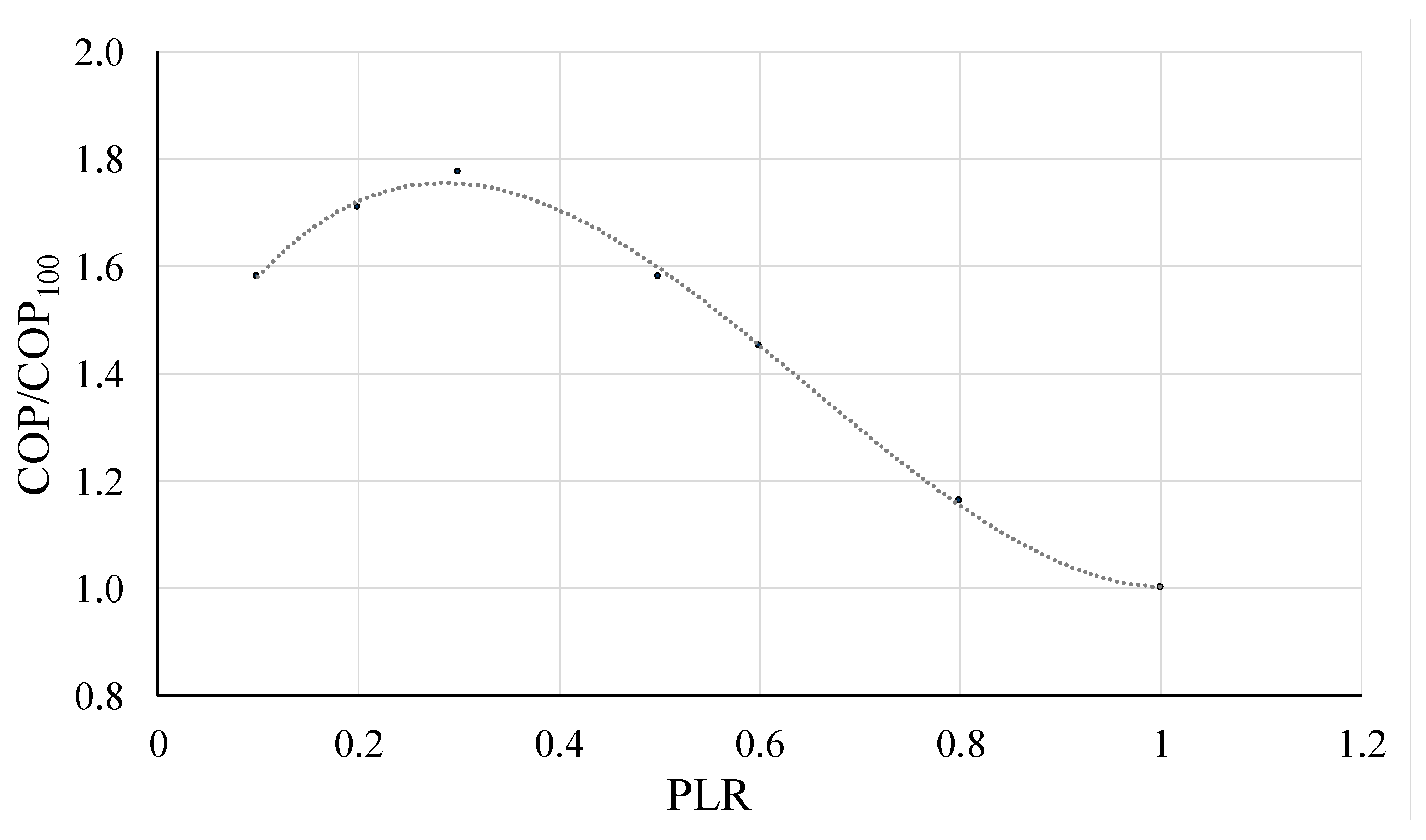
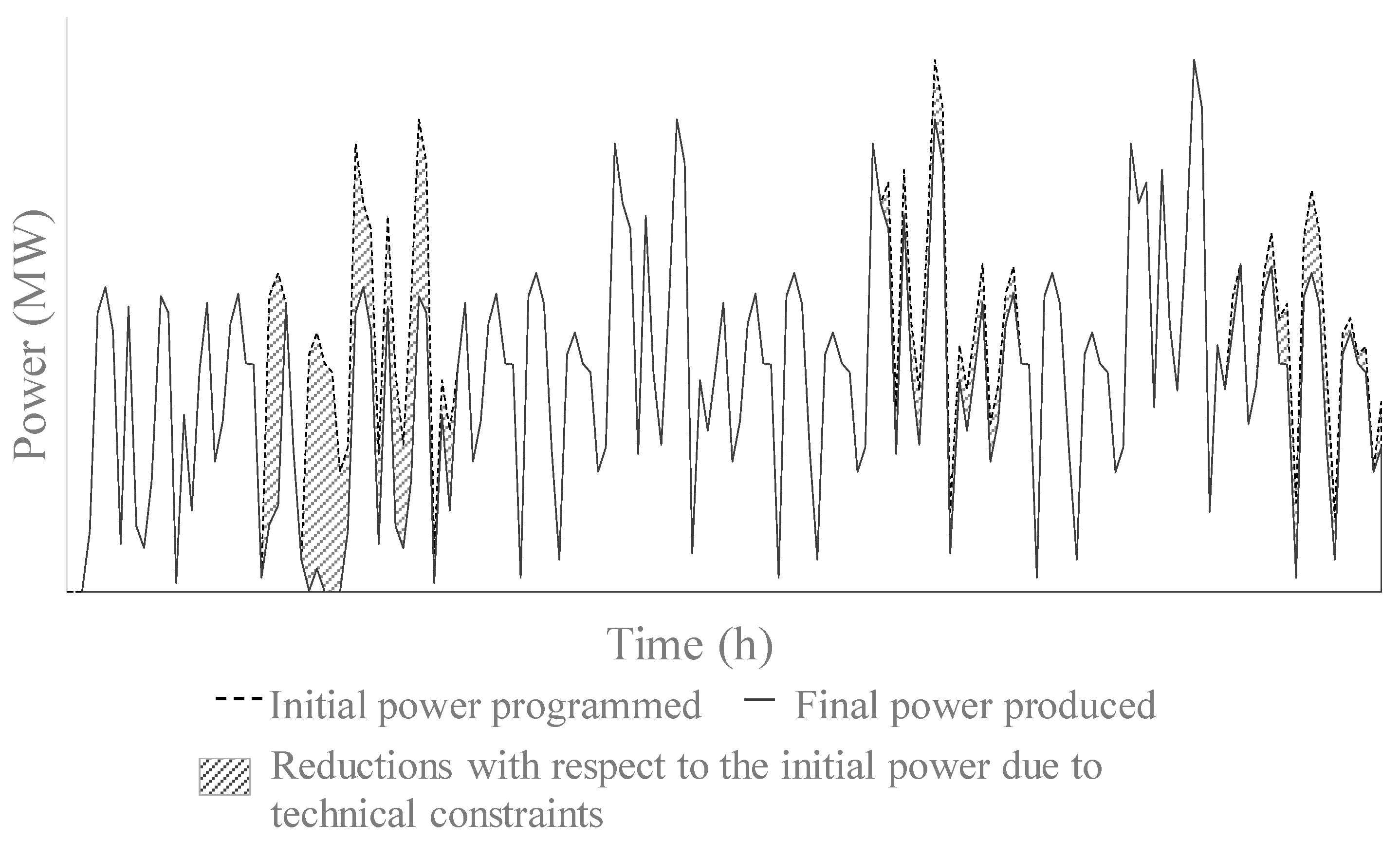
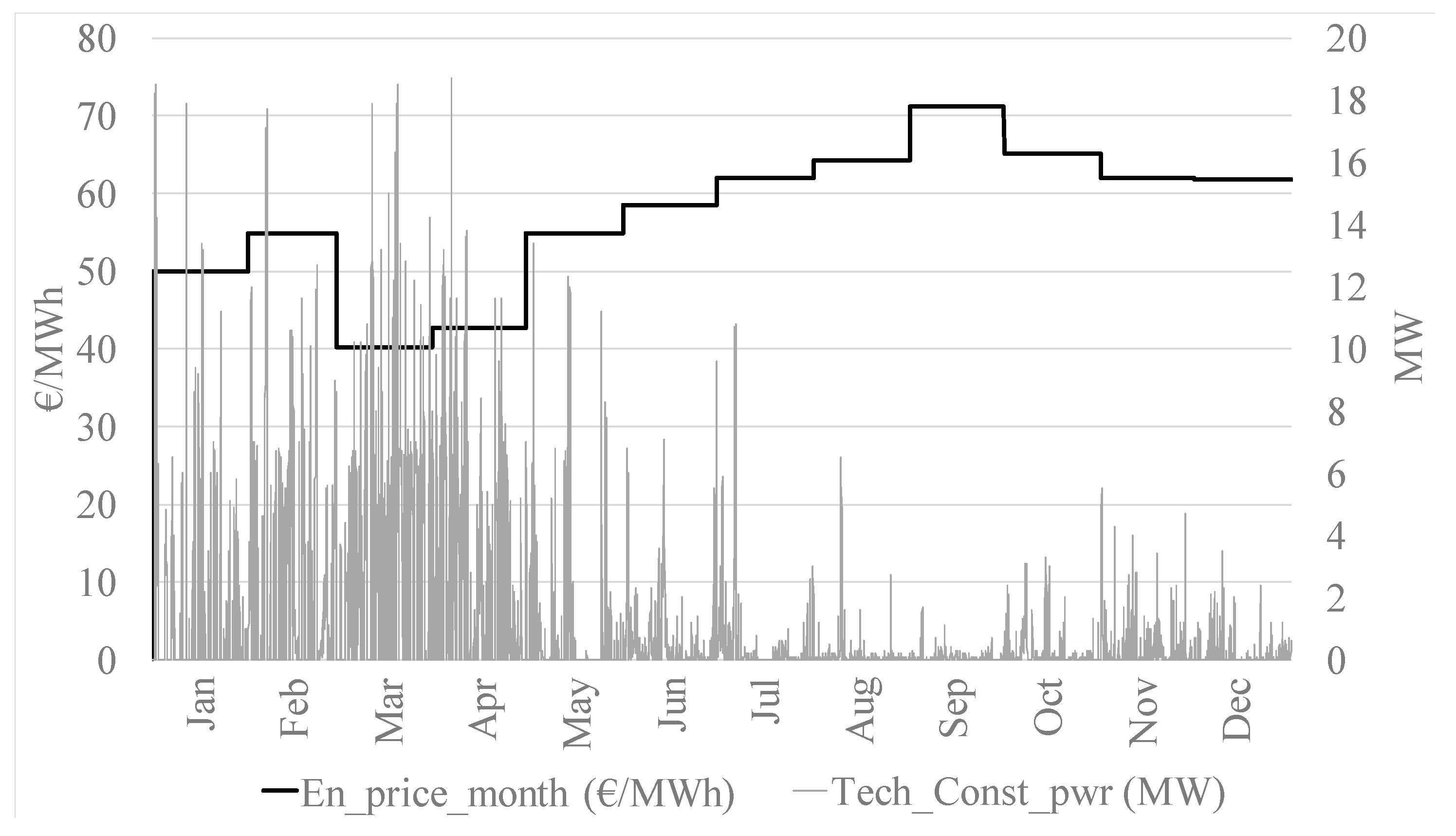
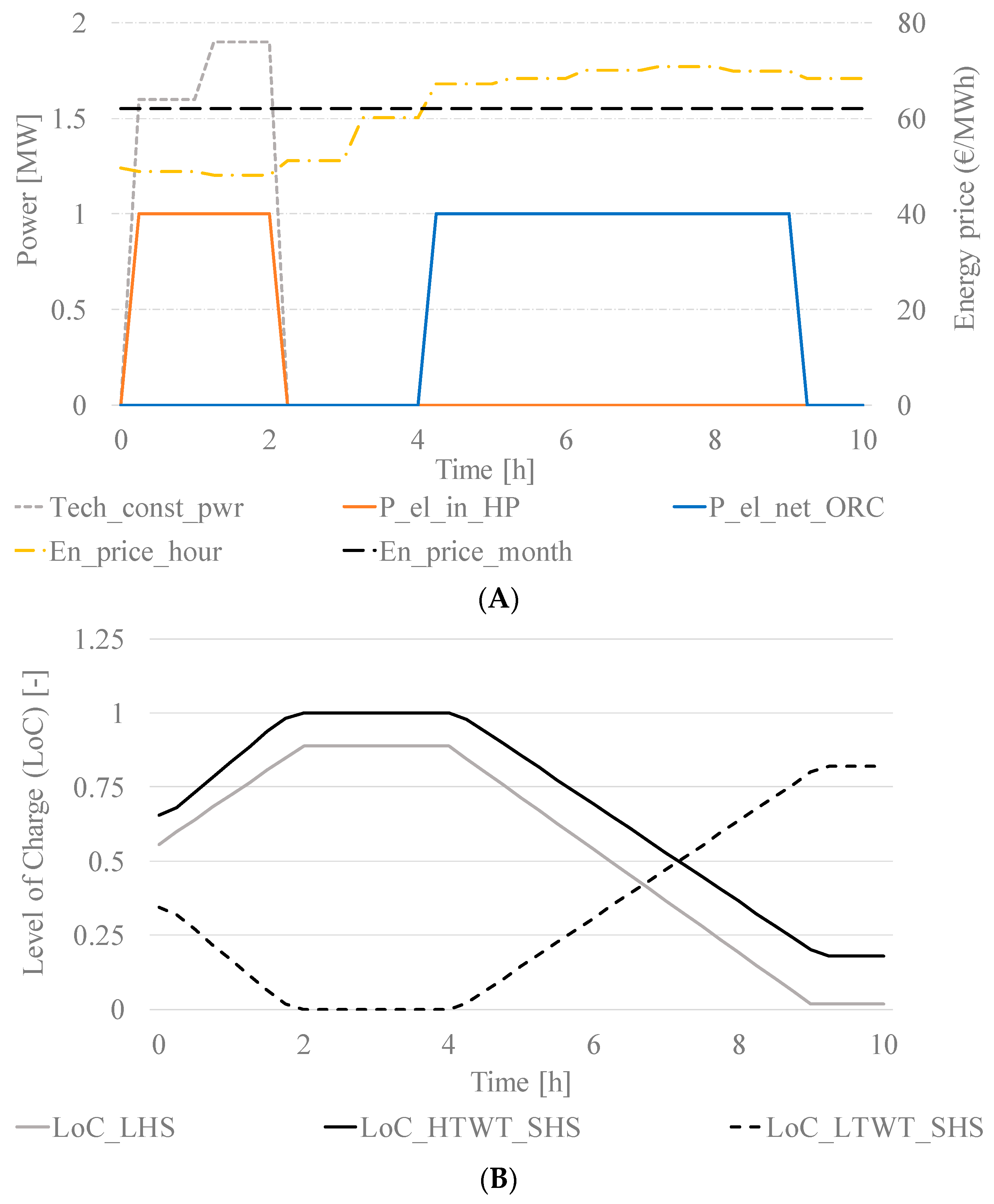
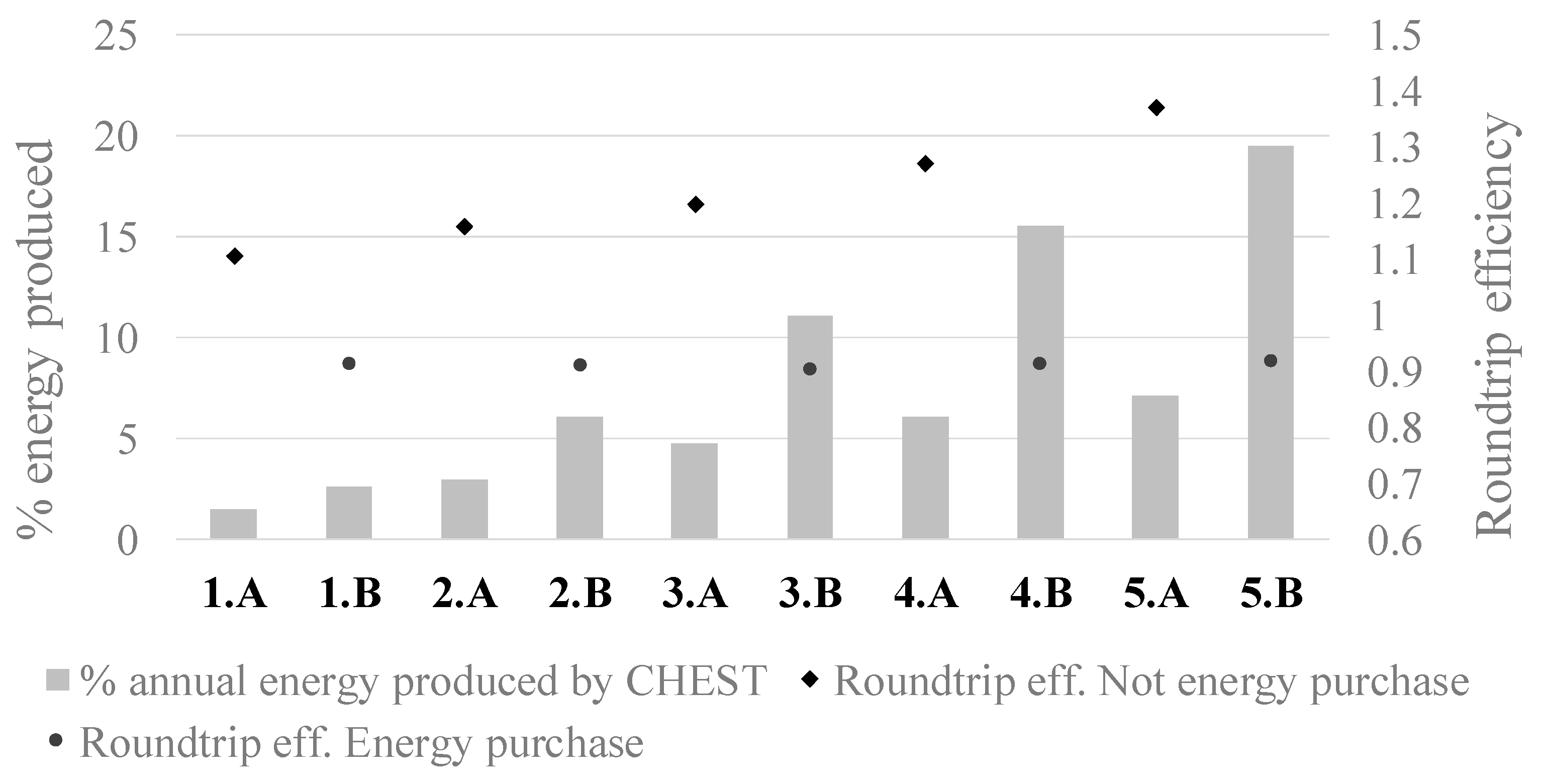
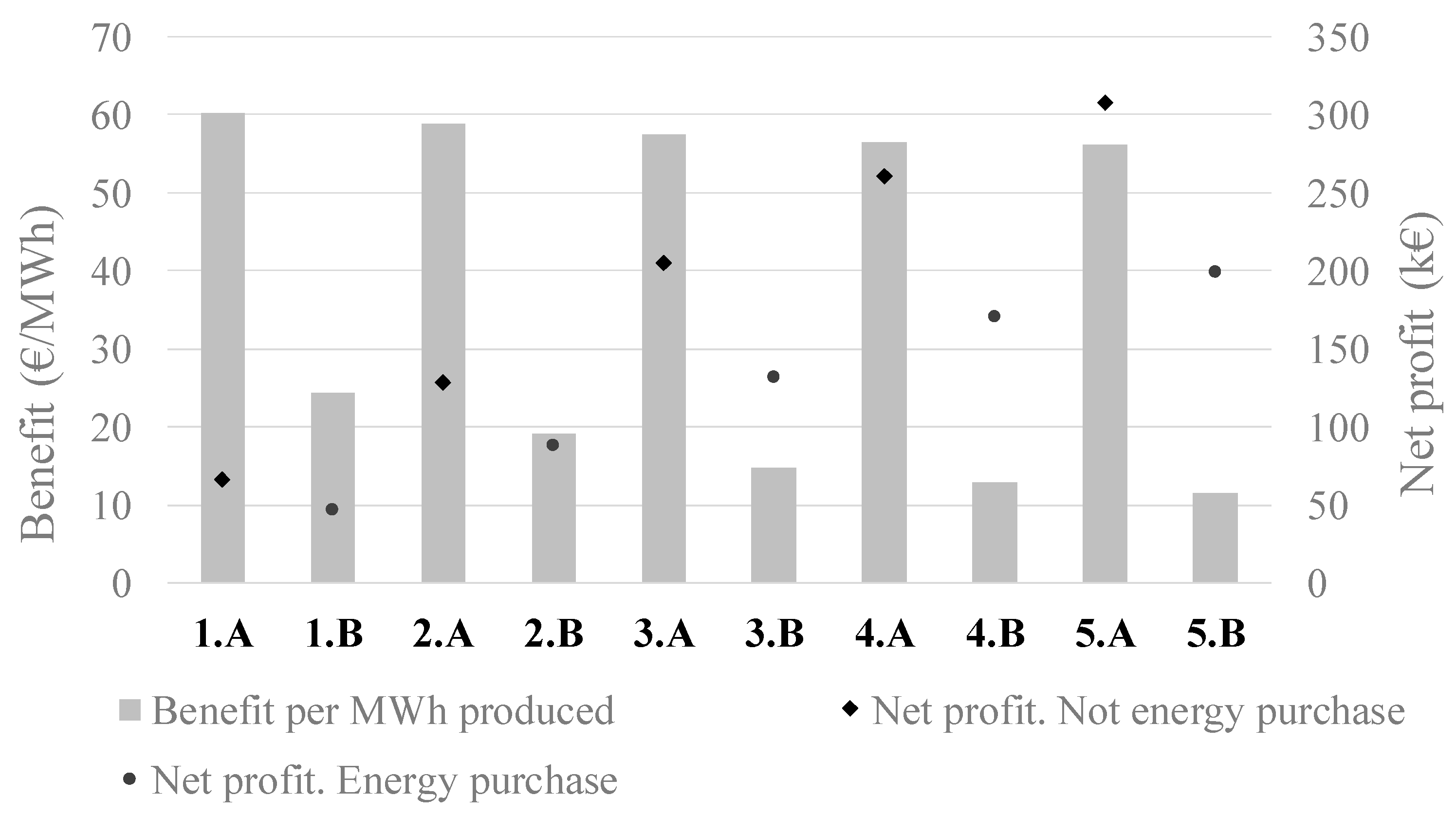
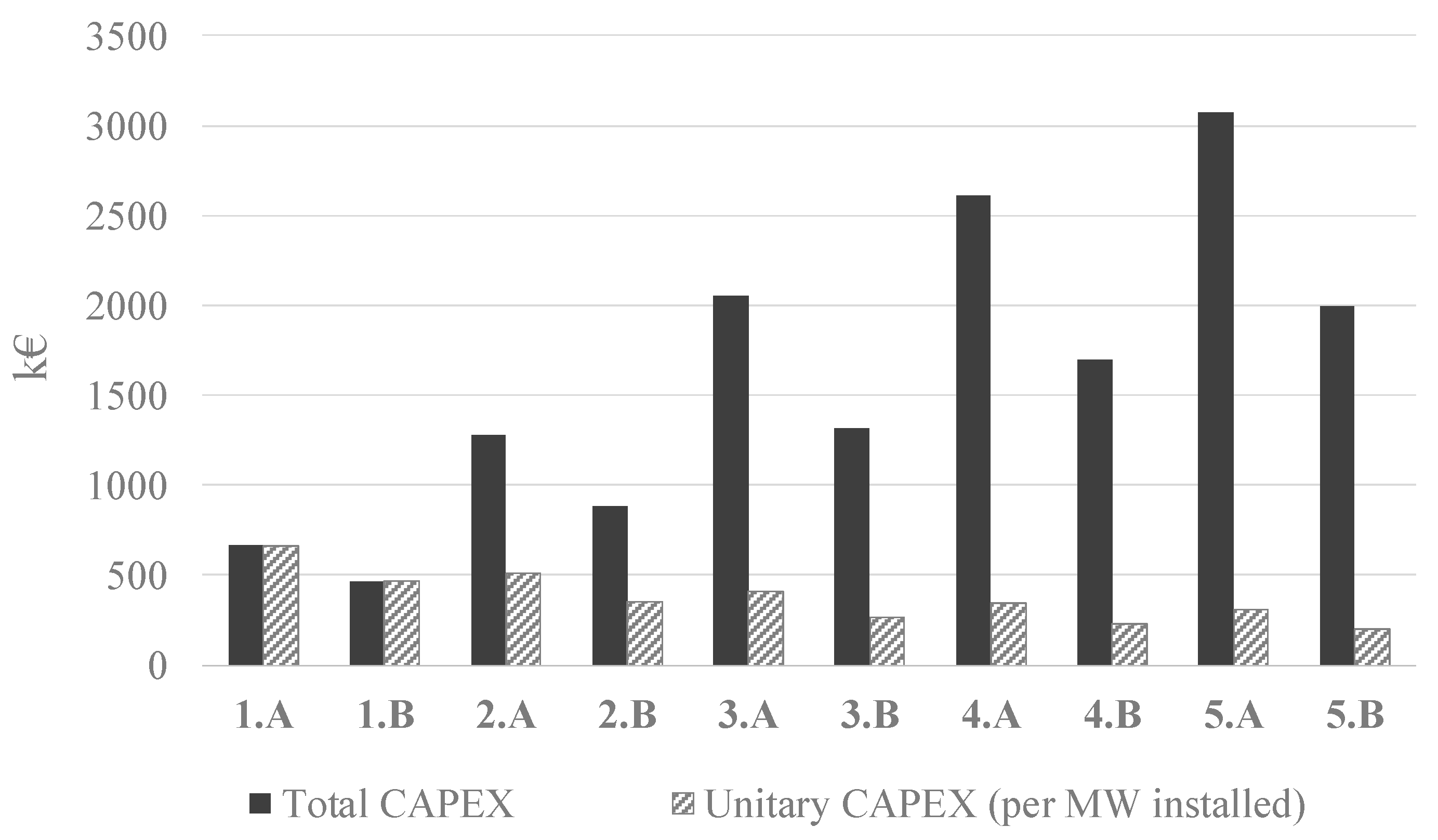
| CASE | Nominal HTHP and ORC Power (MW) | Purchase Energy? |
|---|---|---|
| 1.A | 1 | NO |
| 1.B | 1 | YES |
| 2.A | 2.5 | NO |
| 2.B | 2.5 | YES |
| 3.A | 5 | NO |
| 3.B | 5 | YES |
| 4.A | 7.5 | NO |
| 4.B | 7.5 | YES |
| 5.A | 10 | NO |
| 5.B | 10 | YES |
© 2020 by the authors. Licensee MDPI, Basel, Switzerland. This article is an open access article distributed under the terms and conditions of the Creative Commons Attribution (CC BY) license (http://creativecommons.org/licenses/by/4.0/).
Share and Cite
Sánchez-Canales, V.; Payá, J.; Corberán, J.M.; Hassan, A.H. Dynamic Modelling and Techno-Economic Assessment of a Compressed Heat Energy Storage System: Application in a 26-MW Wind Farm in Spain. Energies 2020, 13, 4739. https://doi.org/10.3390/en13184739
Sánchez-Canales V, Payá J, Corberán JM, Hassan AH. Dynamic Modelling and Techno-Economic Assessment of a Compressed Heat Energy Storage System: Application in a 26-MW Wind Farm in Spain. Energies. 2020; 13(18):4739. https://doi.org/10.3390/en13184739
Chicago/Turabian StyleSánchez-Canales, Violeta, Jorge Payá, José M. Corberán, and Abdelrahman H. Hassan. 2020. "Dynamic Modelling and Techno-Economic Assessment of a Compressed Heat Energy Storage System: Application in a 26-MW Wind Farm in Spain" Energies 13, no. 18: 4739. https://doi.org/10.3390/en13184739
APA StyleSánchez-Canales, V., Payá, J., Corberán, J. M., & Hassan, A. H. (2020). Dynamic Modelling and Techno-Economic Assessment of a Compressed Heat Energy Storage System: Application in a 26-MW Wind Farm in Spain. Energies, 13(18), 4739. https://doi.org/10.3390/en13184739







